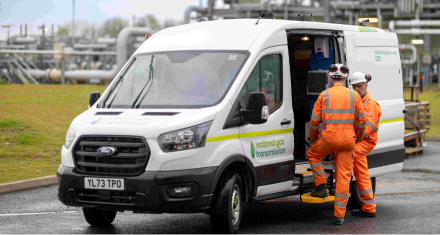National Gas Transmission
Our network and assets
National Gas owns the gas National Transmission System (NTS) in Great Britain, which transports highly pressurised gas at high speed to every part of the country. The NTS is the backbone of Britain’s energy system today and will play a key role in the transition to a clean energy future – through repurposing to transport hydrogen or carbon dioxide (for Carbon Capture and Storage – CCS).
Introducing our high-performance gas transportation network
The National Transmission System consists of nearly 5,000 miles of high-pressure steel pipes and more than 500 above-ground installations. Gas is fed into the NTS from different sources at any of eight gas terminals across Great Britain.
The NTS is the only gas system with compression
We have 60 gas turbines (industrial versions of jet engines) at compressor stations across the country, which pressurise and direct gas throughout the network.
National Gas is the sole owner and operator of this entire system, which is controlled from our National Control Centre (NCC).
Transporting gas throughout Great Britain – and beyond
Our network of pipelines transports gas at high pressure from entry terminals and storage facilities to exit points, where the gas is transferred to:
- The four Gas Distribution Networks (GDNs) for onward supply to homes and business, or
- Directly connected customers, such as power stations, large industrial consumers and gas storage sites.
The NTS also exports gas to the island of Ireland and to continental Europe via connecting pipelines, called interconnectors.

The process of transporting gas from source to customer starts with producing the gas:
- Gas fields in the North Sea – UK Continental Shelf (UKCS) and Norwegian offshore gas fields
- Imports from Belgium and Netherlands (via interconnector pipes)
- Liquified Natural Gas (LNG) imports
- Storage withdrawals
The gas flows into our high-pressure NTS:
- This is the ‘motorway network’ for gas, transporting gas at up to 94 bar pressure (a fully inflated car tyre is about 2 bar)
- Made up of steel pipelines.
- Gas turbines and electric turbines at compressor stations push the gas around the network.
- Third-party gas producers and their appointed shippers decide where to put gas onto the system.
- All controlled by our National Control Centre (NCC), which facilitates the gas markets and ensures gas is transported to where it is needed.
The gas reaches our customers
- These include power stations, industry, gas storage sites and regional Gas Distribution Networks (GDNs).
- Household consumers receive gas via one of the four GDNs: Cadent, Northern Gas Networks, SGN or Wales & West Utilities.
- Households and businesses use gas at lower pressures, which are controlled by the GDNs.
Find out more about how we manage, maintain, protect and expand our incredible energy network:

Network route maps
Discover the network of pipes and assets that comprise the gas National Transmission System (NTS) across Great Britain.
Find out more
Working near our assets
Find out how to work safely and compliantly if you’re planning any construction, excavation or other work near to National Gas pipelines or assets.
Find out more
Planning and development
How we work with local planning authorities and consultees in developing and managing our transmission network and assets, and on other projects around our sites.
Find out more
Landowners, occupiers and grantors
Our network of gas pipes crosses land owned and occupied by third parties. We work with these ‘grantors’ to maintain access rights to our essential assets.
Find out more
Non-operational land
How we manage land in the buffer zone around our operational sites, which may be used by third parties for a variety of purposes.
Find out more
Construction
National Gas undertakes a wide range of construction projects to ensure our pipeline network and assets continue to deliver the capabilities required across the country.

Network Asset Risk Metric (NARM) methodology
Our NARM methodology enables us to quantify and monitor the level of performance that our assets are delivering for customers.
Find out more
